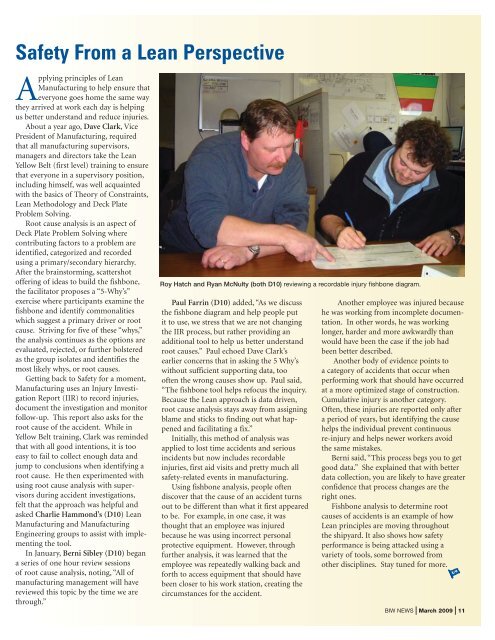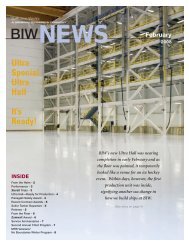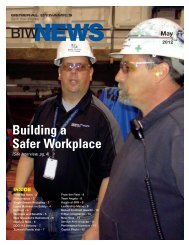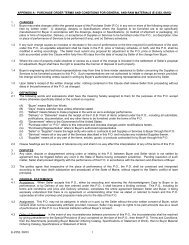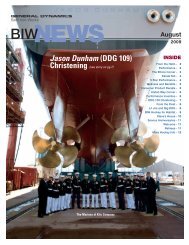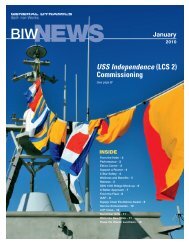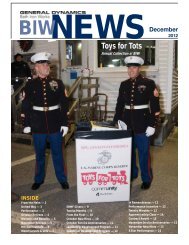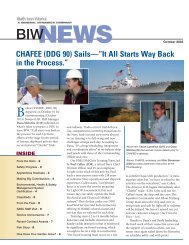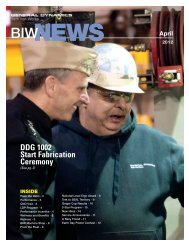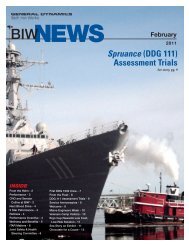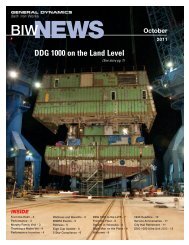January–February <strong>2009</strong>Service AnniversariesJanuary <strong>2009</strong>Dept. Name45 Years81 Alley, Thomas Edward81 Cole, Henry James35 Years09 Bull, Robert Rolland10 Abbott, Scott Barton10 Main, James Carl10 Poulin, Andre Jean15 Brown, Kenneth Michael19 Temple, Dennis Wayne19 Wyman, Alton Douglas20 Brawn, Allen LeRoy32 Turgeon, Paul Maurice40 Bailey, David Roland43 Siegars Jr, Carleton H50 Boardman, Paul Roger81 Carter, Blaine Thomas81 Levesque, Russell Robert81 Watts, Alan Wayne84 Whitmore, Michael Bruce86 Cyr, Marcel Reynold86 Hawkins, David Arthur86 Meserve, Hazel Mae86 Poisson, Roger Normand87 Larkin, Paul Thomas91 Daigle, Joseph Maurice30 Years07 Gauthier, Paul Marcel10 Brooks, David Franklin10 Desrosiers, Jeffrey Bryan10 Medeiros II, Chris Emile10 Niva, Gregory Lee10 Witherell, Kirt Arthur15 Bozeman, Paul Cochran15 Collins, Daniel Seth15 Foley, John Dwaine15 Hooper, Clifford Ruel17 Kanaris, Michael Joseph19 Boynton, Peter Hampton19 Grant, Ronald Myles19 Hubert, Paul David19 Saar, David Louis20 Doyon, Kerry Gerard20 Ethier, Arthur Barry20 Heath, Stephen Pearl20 Murphy, Patrick Lancefield20 Sylvester, Mark James20 Titcomb, Ronald Edward25 Littlefield, David Walter43 Rice, Donald George43 Sheldon, John Crawford45 Rumery, Judith Elaine52 Skelton, Richard Otto69 Murray, Richard Adrien81 Harvey, Gary Allen84 Walker, John Louis86 Snell, Leo William86 Verwey, Scott Lee87 Flower III, Donald WalkerDept. Name87 Kirkpatrick, Stephen Randolph87 Rogers, Sandra Lee91 Ames, Donald Herbert91 Johnson, Eric Weest91 Lee, Carol Lynne91 Pickering, Dennis Edward91 Rego, Michael Louis91 Vallee, Richard Roger25 Years87 Hanna, Thomas Ronald20 Years02 Brown, Louise Cyr09 Semprebon, Michael Duston10 Barter, Todd Michael10 Frizzle, Gary Leon10 Leeman, Joseph Scott10 Lever, Scott Braden10 Paradis, Philippe Adelard11 Salafia, Mark Salvatore15 Boyle, Robert Francis15 Germain, Brian Keith15 Greenleaf II, Murlyn Harold15 Keene, James Russel15 Krook Jr, George Francis15 Lincoln, Carroll Lee15 MacWhinnie, Gary Steven15 Walker, Gregory Scott17 Hitchcock, Dennis Ray17 Holbrook, Thomas Anthony17 Marsters, Ronald Alan17 Smedshammer, Dru Jana19 Beaudoin, Walter Thomas19 Casey, John Andrew19 Chamberlin, Christopher James19 Hood, Richard Elmer19 Sabins, Glenn Alan19 Tynes, John Marshall20 Darling, Richard Maurice20 Scott, Stephen Randolph27 Guay, Sharon Joan27 Stelzer, Laurence William27 Van Meter, Yvonne Risio28 Brooks, Thomas Michael30 Lepage, Marc Antonio62 Pomelow Sr, John Raymond66 Bernard, Ronald Paul69 Jacques, Michael Edmond69 Mason, Roger Lee82 Gonyou, Mary Jean86 Ballard, Edith Elaine86 Russell, Lisa Lynn87 Harris, Beverly Ann87 Jaramillo, Jody Ann87 Rockwell, Shawn Arlit87 Smith, Gary Ford15 Years10 Thatcher, William Richard11 Roy, Michael RonaldNote: February 09 issue of BIW News published the February <strong>2009</strong> rather thanJanuary <strong>2009</strong> service anniversaries. To correct the record, all BIW employeescelebrating January <strong>2009</strong> anniversaries are listed here and those with February<strong>2009</strong> anniversary dates are also shown below. As a rule, anniversary (andretiree) listings are shown one month in arrears.Dept. Name19 Sampson, Penny Darlene24 Lamare, Norman Joseph24 Miller, Lisa Carol27 Daley, Jeannine Theresa27 McKay, Michael Ernest27 Williams, Kenneth Ray40 Dimuccio, Stephen William40 Harrison, Matthew Lee5 Years40 Molello, Minter Michael40 Taylor, Reshanna Greene40 Warren, Thomas Harold75 Kellogg, James Patrick86 Flanagan, David William86 Leazer, Randall Eugene86 Lyzohub, Brian EdwardFebruary <strong>2009</strong>45 Years29 Waltz, Leslie Leroy35 Years06 Peaslee, Timothy Joseph09 Carville, Kenneth Arnold10 Gardner, Delbert William17 Dodge, F Munro19 Spaulding, Steven Willis19 Turner, Richard Allen20 Allen, Marc Andre81 Vinette, Devere Vincent91 Sargent, Christopher Carl30 Years10 Butler, Drew Wade10 Card, Danny Dean15 Butterworth, James Jared17 Gagne, Leo Rudolph17 Richard, Louis Albert19 Bailey, Glen Ellsworth19 Cote, Rene Nelson19 Fullam, Douglas Michael19 Libby Jr, Maurice Edwin19 Williams, David Paul20 Temple, Michael Anthony25 Cardali, Robert Edward25 Saucier, Brian Richard27 Kemberling, Ulrike Brigitte27 Palmer Sr, Joel William38 Perry, Allan Scott40 Farag, Mohamed Abdelhamid43 Paradis, Danny Mark45 Young, Linda Harrington50 Pinette, Fulton Joseph66 Danforth, Kenneth Richard66 Esculano, Edward JosephDept. Name87 Albert, Daniel Wayne87 Garrett, Steven Glenn87 Lane, Reginald Allen90 Pelletier, Dean Roy91 Roy, Robert Lionel25 Years40 St Germain, Diane Dorothy20 Years09 Letourneau, Steven Lester10 Gosse, Bryan David15 Bujold, Paul Robert15 Ferrante, Christopher15 Ouellette, John Leo15 Schrader, John Anthony15 Upham Jr, Albion Leslie15 Wall II, Edward John17 Jellerson, Jonathan Paul19 St Amant, Joseph Lindsay19 Wade, Clarence Michael20 Cote, Maurice Alphonse20 Levesque, Randy Alan24 O’Dare, Susan Larochell24 Pearson, Mark Andrew24 Zerega, Mark Philips27 Costa, Troy Leroy40 Blaisdell, Alan John40 Finn, Gregory Phillip40 Orr, Alan Michael50 Morissette, Lee Raymond50 Rogers, Debra Marie81 London, Cathy Ann86 Barnes, Lisa Marie86 Knowlton, Debbie Lynn87 Oliver, Deborah Ann15 Years27 Cote, Paul Edward27 Piche, Jean Paul10 Years19 Shorette Jr, Lawrence Joseph40 Camp IV, George Hayward40 Hamelin, Jason Roger40 Hubble, William Schenck40 Perkins, Darlene Rae4 0Schuyler, Eric Kemble43 Bernard, Russell Peter84 Peterson, David Wayne84 Watkins Jr, Philip Allen5 Years26 Tellarini, Robert Michael10 | <strong>March</strong> <strong>2009</strong> | BIW NEWS
Safety From a Lean PerspectiveApplying principles of LeanManufacturing to help ensure thateveryone goes home the same waythey arrived at work each day is helpingus better understand and reduce injuries.About a year ago, Dave Clark,VicePresident of Manufacturing, requiredthat all manufacturing supervisors,managers and directors take the LeanYellow Belt (first level) training to ensurethat everyone in a supervisory position,including himself, was well acquaintedwith the basics of Theory of Constraints,Lean Methodology and Deck PlateProblem Solving.Root cause analysis is an aspect ofDeck Plate Problem Solving wherecontributing factors to a problem areidentified, categorized and recordedusing a primary/secondary hierarchy.After the brainstorming, scattershotoffering of ideas to build the fishbone,the facilitator proposes a “5-Why’s”exercise where participants examine thefishbone and identify commonalitieswhich suggest a primary driver or rootcause. Striving for five of these “whys,”the analysis continues as the options areevaluated, rejected, or further bolsteredas the group isolates and identifies themost likely whys, or root causes.Getting back to Safety for a moment,Manufacturing uses an Injury InvestigationReport (IIR) to record injuries,document the investigation and monitorfollow-up. This report also asks for theroot cause of the accident. While inYellow Belt training, Clark was remindedthat with all good intentions, it is tooeasy to fail to collect enough data andjump to conclusions when identifying aroot cause. He then experimented withusing root cause analysis with supervisorsduring accident investigations,felt that the approach was helpful andasked Charlie Hammond’s (D10) LeanManufacturing and ManufacturingEngineering groups to assist with implementingthe tool.In January, Berni Sibley (D10) begana series of one hour review sessionsof root cause analysis, noting, “All ofmanufacturing management will havereviewed this topic by the time we arethrough.”Roy Hatch and Ryan McNulty (both D10) reviewing a recordable injury fishbone diagram.Paul Farrin (D10) added, “As we discussthe fishbone diagram and help people putit to use, we stress that we are not changingthe IIR process, but rather providing anadditional tool to help us better understandroot causes.” Paul echoed Dave Clark’searlier concerns that in asking the 5 Why’swithout sufficient supporting data, toooften the wrong causes show up. Paul said,“The fishbone tool helps refocus the inquiry.Because the Lean approach is data driven,root cause analysis stays away from assigningblame and sticks to finding out what happenedand facilitating a fix.”Initially, this method of analysis wasapplied to lost time accidents and seriousincidents but now includes recordableinjuries, first aid visits and pretty much allsafety-related events in manufacturing.Using fishbone analysis, people oftendiscover that the cause of an accident turnsout to be different than what it first appearedto be. For example, in one case, it wasthought that an employee was injuredbecause he was using incorrect personalprotective equipment. However, throughfurther analysis, it was learned that theemployee was repeatedly walking back andforth to access equipment that should havebeen closer to his work station, creating thecircumstances for the accident.Another employee was injured becausehe was working from incomplete documentation.In other words, he was workinglonger, harder and more awkwardly thanwould have been the case if the job hadbeen better described.Another body of evidence points toa category of accidents that occur whenperforming work that should have occurredat a more optimized stage of construction.Cumulative injury is another category.Often, these injuries are reported only aftera period of years, but identifying the causehelps the individual prevent continuousre-injury and helps newer workers avoidthe same mistakes.Berni said, “This process begs you to getgood data.” She explained that with betterdata collection, you are likely to have greaterconfidence that process changes are theright ones.Fishbone analysis to determine rootcauses of accidents is an example of howLean principles are moving throughoutthe shipyard. It also shows how safetyperformance is being attacked using avariety of tools, some borrowed fromother disciplines. Stay tuned for more.BIW NEWS | <strong>March</strong> <strong>2009</strong> | 11


